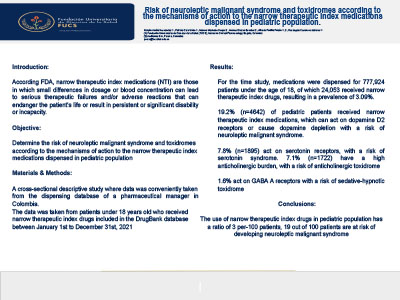ABSTRACTS
Risk of Neuroleptic Malignant Syndrome and Toxidromes According to the Mechanisms of Action to the Narrow Therapeutic Index Medications Dispensed in the Pediatric PopulationAuthor: Patricia Caro, Marylin Acuña, Manual Machado, Andrea Orozco, Alfredo Portilla, and Angela Casanova<p><strong>Introduction:</strong></p> <p>According the US Food and Drug Administration (FDA), narrow therapeutic index (NTI) medications are those in which s | | Associate Authors:
Introduction: According the US Food and Drug Administration (FDA), narrow therapeutic index (NTI) medications are those in which small differences in dosage or blood concentration can lead to serious therapeutic failures and/or adverse reactions that can endanger the patient's life or result in persistent or significant disability or incapacity. Objective: To determine the risk of neuroleptic malignant syndrome and toxidromes according to the mechanisms of action to the NTI medications dispensed in the pediatric population. Methods: A cross-sectional descriptive study was performed based on data from the dispensing database of a pharmaceutical manager in Colombia. Data was collected from patients younger than 18 years who received NTI medications included in the DrugBank database between January 1, 2021, and December 31, 2021. Results: Over the study period, medications were dispensed to 777,924 patients younger than 18 years. Of those, 24,053 received NTI medications, resulting in a prevalence of 3.09%. A total of 4642 (19.2%) of the patients received NTI medications that can act on dopamine D2 receptors or cause dopamine depletion, with a risk of neuroleptic malignant syndrome. A total of 1895 (7.8%) received NTI medications that act on serotonin receptors, with a risk of serotonin syndrome. A total of 1722 (7.1%) received NTI medications with a high anticholinergic burden, with a risk of anticholinergic toxidrome, and 1.6% received NTI medications that act on GABA A receptors, with a risk of sedative-hypnotic toxidrome. Conclusion: In a pediatric population, 3 in every 100 patients received an NTI medication, and 19 out of 100 patients were at risk of developing neuroleptic malignant syndrome.
|

